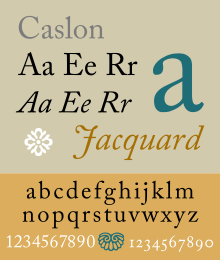Rotated letter
In the days of printing with metal type sorts, it was common to rotate letters and digits 180° to create new symbols. This was done for example with the Palaeotype alphabet, the International Phonetic Alphabet, the Fraser script, and for some mathematical symbols. Perhaps the earliest instance of this that is still in use was turned e for schwa.

In the eighteenth-century Caslon metal fonts, the British pound sign (£) was identical to an italic uppercase J, rotated 180 degrees.[1]
Unicode support
The following rotated (turned) letters are supported by Unicode.
Latin
Parentheses mark letters that stand in for themselves or for another. For instance, a rotated 'b' would be a 'q', and indeed some physical typefaces didn't bother with distinct sorts for those letters, while a rotated 's' would be itself. Long s with a dot, ⟨ſ̣⟩, can stand in for a rotated j.
An en dash marks small caps that would not be very distinct from the turned lower case letter, though they are possible: turned small cap c is supported, for example (ᴐ).
The Fraser script creates a number of duplicates of the rotated capitals.
| A | B | C | D | E | F | G | H | I | J | K | L | M | N | O | P | Q | R | S | T | U | V | W | X | Y | Z | |
|---|---|---|---|---|---|---|---|---|---|---|---|---|---|---|---|---|---|---|---|---|---|---|---|---|---|---|
| Rotated minuscule | ɐ·ɒ | (q) | ɔ | (p) | ə·ǝ | ɟ[2] | ᵷ·ɓ | ɥ | ᴉ | (ſ̣) | ʞ | ꞁ | ɯ | (u) | (o) | (d) | (b) | ɹ | (s) | ʇ | (n) | ʌ | ʍ | (x) | ʎ | (z) |
| Rotated small cap | ᴐ | ⱻ | ⅎ | (ʜ) | (ɪ) | ɾ[2] | (ɴ) | (ᴏ) | ᴚ | (ꜱ) | – | – | (x) | (ᴢ) | ||||||||||||
| Rotated capital | Ɐ | Ɔ | Ǝ | Ⅎ | ⅁ | (H) | (I) | Ʞ | Ꞁ·⅂ | ꟽ | (N) | (O) | (S) | Ʇ | Ʌ | (X) | ⅄ | (Z) | ||||||||
| Fraser | ꓯ | ꓭ | ꓛ | ꓷ | ꓱ | ꓞ | ꓨ | (ꓧ) | (ꓲ) | ꓩ | ꓘ | ꓶ | – | (ꓠ) | (ꓳ) | ꓒ | – | ꓤ | (ꓢ) | ꓕ | ꓵ | ꓥ | – | (ꓫ) | – | (ꓜ) |
The letters ⅁, ⅂, ⅄ are specified as sans-serif. Additional small cap forms are found in the literature (e.g. turned ᴀ ᴋ ʟ ᴜ), but are not supported as of Unicode 13. Turned ɢ was added to the extIPA in 2015 and should have Unicode support soon.
Other rotated letters include the digraphs ᴂ and ᴔ. The "rotated" capital Q in Unicode is only turned 90 degrees: ℺.
Greek
Many of the few rotated Greek letters are intended for mathematical notation. An en dash marks Greek capital letters that are not distinct from a Latin letter. Reversed L, ⟨⅃⟩, can stand in for a rotated gamma Γ, though it is defined as sans serif.
| Α | Β | Γ | Δ | Ε | Ζ | Η | Θ | Ι | Κ | Λ | Μ | Ν | Ξ | Ο | Π | Ρ | Σ | Τ | Υ | Φ | Χ | Ψ | Ω | |
|---|---|---|---|---|---|---|---|---|---|---|---|---|---|---|---|---|---|---|---|---|---|---|---|---|
| Rotated minuscule | ƍ | ᴈ·϶ | (θ) | ℩ | (ο) | (χ) | ||||||||||||||||||
| Rotated capital | – | – | (⅃) | ∇ | – | (Ζ) | (Η) | (Θ) | (Ι) | – | – | – | (Ν) | (Ξ) | (Ο) | ⨿ | – | – | (Φ) | (Χ) | ℧ |
In addition, the horseshoe ʊ ᶷ of the IPA is a turned small-capital ℧.
Other
Other rotated symbols include ɞ (rotated or reversed ʚ), ʖ (rotated ʕ) ⱹ (rotated ɽ), ɺ (rotated ɼ), ʁ (equivalent to rotated Cyrillic я, though historically it's an inverted Latin ʀ), the digits ↊ and ↋, the insular g Ꝿ ꝿ, and the ampersand ⅋. The 'turned comma' ⟨‘⟩ is, as its name suggests, a rotated comma. It is used for the Hawaiian letter ʻokina. Spanish uses the rotated punctuation marks ¡ and ¿.
In addition to turned letters, Unicode supports a few reversed (mirror-image) letters such as ɘ, Ƨ ƨ, Ƹ ƹ, ʕ, ᴎ, ᴙ, ꟻ, ⅃ and ꟼ; Cyrillic Ԑ ԑ (reversed З з) and Ꙡ ꙡ (as well as Cyrillic И и and Я я, which are graphically equivalent to reversed Latin N ɴ and R ʀ), superscript ᶟ ᴻ, and the tresillo Ꜫ ꜫ, which historically is a reversed three. IPA ɜ is officially a reversed rather than rotated ɛ.
